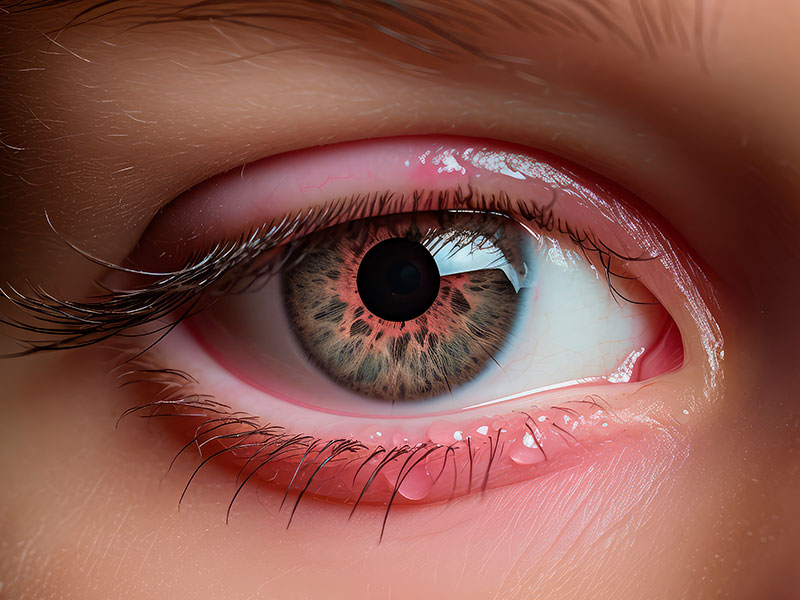Overview
Bacterial eye infections are common and can affect individuals of any age. These infections typically result from the introduction of harmful bacteria to the eye’s surface or surrounding structures. While many bacterial eye infections are mild and easily treatable, others can become serious if left unaddressed, leading to complications such as corneal damage or vision loss.
Recognizing symptoms early and seeking appropriate care can help ensure a smooth recovery and protect long-term eye health.
What is a Bacterial Eye Infection?
A bacterial eye infection occurs when bacteria enter and multiply within the eye or the surrounding tissues. These infections may involve different parts of the eye, including the conjunctiva, cornea, or eyelids. The most frequently diagnosed bacterial infections include conjunctivitis, keratitis, and blepharitis. These infections can result from various sources, including contaminated hands, improper use of contact lenses, or eye injuries.
Most bacterial eye infections are caused by common bacteria such as Staphylococcus aureus, Streptococcus pneumoniae, or Haemophilus influenzae. The type of bacteria involved, the part of the eye affected, and the individual’s overall health all play a role in determining the severity of symptoms and the most appropriate treatment approach.
In many cases, bacterial eye infections can be resolved with antibiotic treatment. However, more serious infections may require a more intensive or prolonged course of therapy. When managed appropriately, most people recover without long-term effects.

Symptoms of Bacterial Eye Infection
The symptoms of a bacterial eye infection can vary depending on the specific type of infection and its severity. Some signs may develop gradually, while others can appear suddenly. Common symptoms include:
- Redness in one or both eyes
- Swelling of the eyelids or surrounding tissues
- Discharge from the eye, which may be yellow, green, or white
- A sensation of burning, grittiness, or itching
- Pain or discomfort in the affected eye
- Increased tearing
- Blurred vision or light sensitivity
- Crusting of the eyelids, especially noticeable upon waking
- A feeling that something is stuck in the eye
Because many symptoms can overlap with other eye conditions, it is important to consult a healthcare provider for a proper diagnosis and treatment plan.
Types of Bacterial Eye Infections
There are several types of bacterial eye infections, each affecting different parts of the eye and requiring specific forms of treatment.
Bacterial Conjunctivitis
Also known as “pink eye,” bacterial conjunctivitis is one of the most common forms of eye infection. It affects the conjunctiva, the thin membrane covering the white of the eye and the inside of the eyelids. It usually causes redness, discharge, irritation, and sometimes mild swelling. This condition may affect one or both eyes and can spread easily, especially in shared environments such as schools or workplaces. Treatment typically includes antibiotic eye drops or ointment.
Bacterial Keratitis
This is a more serious bacterial infection that affects the cornea, the transparent front part of the eye. It often occurs in individuals who wear contact lenses, particularly when lenses are worn for extended periods or not properly cleaned. Bacterial keratitis can cause significant eye pain, redness, sensitivity to light, and vision changes. It requires prompt medical attention, as delayed treatment can lead to corneal scarring or vision loss.
Blepharitis
Blepharitis refers to inflammation of the eyelid margins, often involving bacterial overgrowth along the base of the eyelashes. It can cause symptoms such as redness, flaking, irritation, and a burning sensation in the eyes. While it is usually not contagious or sight-threatening, blepharitis can become a chronic condition that requires ongoing eyelid hygiene and sometimes antibiotic treatment.
Causes of Bacterial Eye Infections
Bacterial eye infections can occur for various reasons, often resulting from the introduction of bacteria from an external source. Common causes include:
- Touching or rubbing the eyes with unclean hands
- Poor contact lens hygiene, including improper cleaning or extended wear
- Using expired or contaminated eye makeup
- Exposure to bacteria in water, such as swimming in untreated pools or lakes
- Complications from eye surgery or injuries
- Weakened immune system due to illness or medications
In children, bacterial conjunctivitis often spreads easily in group settings through direct or indirect contact with infected individuals. Adults may acquire infections through the use of contact lenses, occupational exposures, or pre-existing health issues.
Risk Factors
Although anyone can develop a bacterial eye infection, certain factors may increase the risk. These include:
- Wearing contact lenses, particularly when not cleaned or stored properly

- Existing skin conditions, such as rosacea or seborrheic dermatitis, which can contribute to blepharitis
- Recent eye surgery or trauma
- Chronic dry eye or use of immunosuppressive medications
- Exposure to crowded environments where bacteria spread easily
Understanding these risk factors can help individuals take preventive steps and seek prompt treatment if symptoms develop.
Diagnosing a Bacterial Eye Infection
Diagnosis typically begins with a physical examination by an eye care professional. The provider will ask about the onset and progression of symptoms and examine the eyes using a slit lamp or magnifying device to observe signs of infection.
In some cases, a sample of eye discharge may be collected and sent to a laboratory for identification of the specific bacteria involved. Bacterial identification can help guide the choice of antibiotics, particularly in more severe or treatment-resistant infections.
Treatment Options
Treatment for bacterial eye infections varies based on the location and severity of the infection. Most mild to moderate infections are effectively treated with topical antibiotics in the form of eye drops or ointments. More serious infections may require oral antibiotics or, in rare cases, intravenous therapy.
Commonly prescribed medications include:
- Besifloxacin (Besivance)
- Tobramycin/dexamethasone (Tobradex)
- Moxifloxacin
- Gatifloxacin
- Erythromycin ointment
In the case of bacterial keratitis or blepharitis, treatment may also include:
- Discontinuing contact lens use during treatment
- Applying warm compresses to the eyelids to relieve discomfort and reduce crusting
- Using artificial tears to help maintain moisture and comfort
- Practicing good eyelid hygiene, including cleaning with diluted baby shampoo or prescribed lid scrubs
For chronic or recurring blepharitis, long-term eyelid care and periodic use of antibiotics may be necessary to manage symptoms and prevent flare-ups.
Patient Assistance Programs may be available for many of these medications. Individuals are encouraged to speak with their pharmacist or healthcare provider to explore cost-saving options and ensure adherence to treatment plans. You can also reach out to The RX Advocates to see if you qualify.
Preventing Bacterial Eye Infections
Good hygiene is key to preventing bacterial infections of the eye. Effective prevention measures include:
- Washing hands thoroughly before touching the eyes or handling contact lenses
- Cleaning and storing contact lenses according to the manufacturer’s and eye care provider’s instructions
- Avoiding the use of expired or shared makeup products
- Protecting the eyes from dust or debris in environments with poor air quality
- Using protective eyewear in settings where there is a risk of eye injury or contamination
- Avoiding swimming in untreated or contaminated water while wearing contact lenses
When to Seek Medical Attention
Prompt medical attention is essential when symptoms of an eye infection are present. If symptoms worsen, do not improve within a few days of treatment, or involve severe pain, changes in vision, or light sensitivity, individuals should consult an eye care provider as soon as possible. Early treatment can help prevent complications and support a faster recovery.
